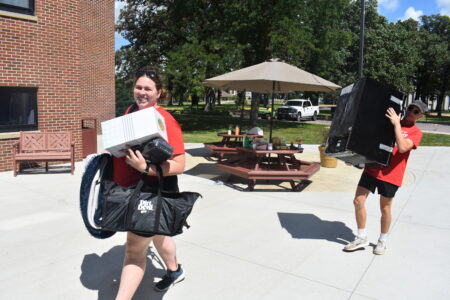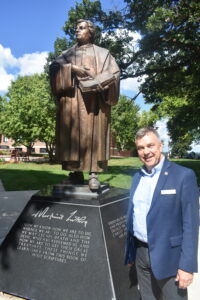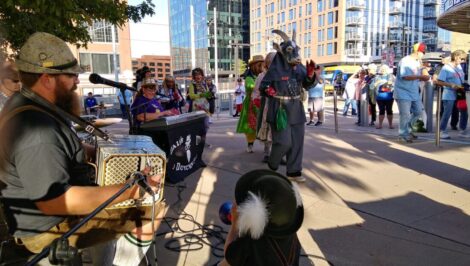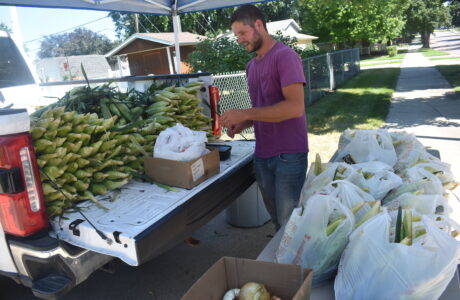NU retailers generate $41M in sales annually, chamber speaker says
Minnesota Retailers Association president shares trends at Hot Topic Series

Bruce Nustad, President of Minnesota Retailer Association led a discussion on retail trends at Lykke Books as part of the New Ulm Chamber’s Hot Topics event.
NEW ULM – Representatives of New Ulm retail engaged with a conversation on the local business landscape, Friday.
Minnesota Retailers Association President Bruce Nustad visited New Ulm as part of the New Ulm Area Chamber’s Hot Topic series, hosted at Lykke Books.
Nustad opened the discussion with retail figures. In New Ulm, there were an estimated 212 retail businesses. He explained this number might seem high, but there are many home-based businesses and people with small part-time businesses. He said people who sell products through Etsy are considered retailers. Nustad said in a community New Ulm’s size, there could be 20 people selling products online as a side job.
“It is easier than ever to run a business from home,” he said.
Overall, there are 1,800 retail-supported jobs in New Ulm, Nustad reported. He also said New Ulm generates $41 million in retail sales annually and statewide, retail contributes $84.8 billion to Minnesota’s GDP.
In addition, around one out every four dollars in state aid money is from retail sales tax collections.
“You are the free tax collection service for Minnesota,” he said.
Nustad said he was a little concerned Minnesota was reaching a plateau in retail sales. He said the pandemic actually gave a boost to retail, but he sees growth leveling off. However, Nustad acknowledged it was difficult to predict long-term trends because daily changes in the market.
“We get information way quicker than in my parents’ day,” Nustad said. It is easier for the average consumer to react to new information.
Tariffs were a great example of it. People who are worried about tariffs might make holiday purchases today instead of waiting for prices to increase. Then, the tariffs get paused. Then they are delayed for 90 days.
“There is a lot of stuff to react to and figure out,” Nustad said. “I think the consumer reacts to the information that is available on a daily basis and that makes it tricky.”
Roger Klockziem of Treasurer Haus said he believed the American consumers were tolerate of fluctuations in the market, but most people were taking a ‘wait and see’ approach.
Nustad said the economic pressures connected to tariffs was current concern, even with retailers selling American made products. Nustad asked if all the raw materials were made in the United States. The beer might be brewed locally, but where did the aluminum for the cans come from?
These economic pressures were impacting more affluent Minnesotans are cutting back. Consumers with disposable incomes are concerned about rising costs.
Another major challenge facing retailers was a change in technology. Nustad said many customers expect a seamless shopping experience between online or in-store. How does a brick and mortar store compete with online sales?
Nustad said the benefit of buying from a physical store, the taxes go back to the community and help improve schools.
Klockziem asked if Minnesota Retailers were seeing customer loyalty in terms of shopping local.
Nustad said his association studied this issue and found Minnesota was unique mix. Many were willing to buy local over shopping online. He said Minnesota had done a great job of promoting shop local, but there limits if the cost were too high.
Jeanie Hinsman said she believed New Ulm residents did mostly buy locally, but she felt tourism played a large role in retail economy. She asked if there was a way to break down retail sales by tourist versus local.
Economic Development Authority (EDA) coordinator Heather Bregel said the city is budgeting to purchase artificial intelligence software that tracks foot traffic and help optimize retail performances. This could help retail businesses who is shopping in New Ulm and from where.
Brie Taralson of Lykke Books asked how to get consumers to shop in store instead of online.
Nustad said the trick is creating a customer experience.
“If you can keep that shopper downtown a little longer, they are more likely to buy that book,” he said. “We are competing in a transaction economy, but we are selling an experience.”
The discussion switch to ways the different businesses could help each other. Nustad said he visited communities that were able to improve retails sales by keeping businesses open later.
Hinsman said at New Ulm’s Own, staff will work to promote the other businesses in town to their customers.
Nustad recommended looking for a next level feature or experience for each business. He used the example of Taylor Swift releasing new albums at Target. For a temporary time, her new album is only available at Target, which brings people in. He asked everyone to ask, who or what is the “Taylor Swift” for a specific market?
Following the discussion, Taralson said the question stayed and she wondered what is the next level thing for Lykke Books.
“It’s not a person,” she said. “It’s the stuff that happens downtown.” She cited Car Roll-in on Saturday, the Spikin’ in the Street event. It was even the music that was piped in through downtown.
She said recently an out of town customer asked where the music was coming from. He said it was strange to hear, but he liked it.





